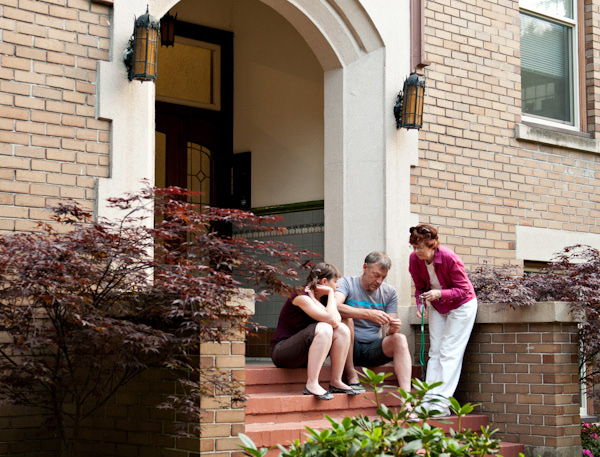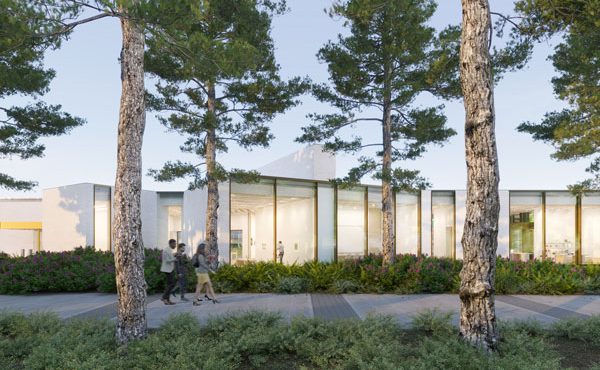
[Editor’s Note: Vancouver revels in its reputation as North America’s most ‘livable’ city. Yet for as many as half of Vancouver’s households and thousands of others across Metro who rent rather than own their accommodation, finding a place to come home to can mean a nail-biting search. More worrisome still, even once an affordable rental has been found, it can be abruptly snatched away again. In this installment of our latest reader-funded Tyee Fellowship series, journalist Jackie Wong investigates one common practice that has a growing number of renters up in arms. (Read her first report here.)]
The hallways in The Seafield apartment building have been stripped of their carpets. Pebbles and dust line the dark walls. It’s the first day of March, and the 80-year-old, 14-unit walkup in Vancouver’s West End is in rough shape — in more than one sense. For two and a half years, the Pendrell Street dwelling has been the site of a vocal battle between the people who until recently owned The Seafield, and the people who live there.
Brothers-in-law Chris Nelson and Jason Gordon purchased the building for $3,447,000 in July 2008, through their company Gordon Nelson Inc. (GNI). Over the following months GNI issued a number of eviction notices, claiming it needed the suites vacated in order to renovate the elderly building.
Tenants protested. As they saw it, once in possession of a vacant renovated suite the landlords could increase the rent, collecting more from new tenants than they would from its former occupants. Residents regarded the derelict conditions in the hallways as intimidation tactics, meant to motivate tenants to move out on their own when eviction notices weren’t enough.
Over the following year, 17 Seafield tenants took their disputes with GNI to the Residential Tenancy Branch (RTB), the B.C. agency in charge of landlord-tenant relations. After hearings and appearances that reached as far as the B.C. Supreme Court, the Branch found that GNI had acted in bad faith in serving its evictions. GNI’s primary motive of achieving a substantial rent increase, dispute resolution officer D. Vaughn wrote in a finding, undermined its claim that vacant suites were required for renovations.
On Feb. 23, 2011, GNI announced it had sold The Seafield for $3,689,000 to a company listed as 1436 Pendrell Street Holdings Inc., with a Gastown address not far from Nelson and Gordon’s Water Street office.
Paying her rent to the new owners for the first time on the day I visited, Seafield tenant Wendy Stephenson hopes for a new era of peace. “It’s such a waste,” she says of the drawn-out legal battle. “We could be doing other things, contributing to the community, besides creating evidence packages, binders, going to all your friends and getting statements.”
A community or an investment?
Peace may come to The Seafield, but such ‘renovictions’ — as they’re called by Vancouver renters who’ve experience them — have played out across the West End for years. Renters constitute 80 per cent of households in the neighbourhood, according to the 2006 Census — the highest concentration in Vancouver. But tenants are the majority in several other neighborhoods as well, including Mount Pleasant (67.2 per cent), Fairview (59.6 per cent), and Kitsilano (56.8 per cent). Stephenson moved into her apartment in Feb. 1977, the week her daughter turned six. Rent then was $256 per month; now it’s $1,367.
Greeting me at the doorway, she apologizes for the derelict hallway. “It’s so embarrassing,” she sighs. Inside her apartment, sunshine fills the kitchen. Every nook in the two-bedroom suite is filled with family photographs, knick-knacks, and old report cards from her daughter’s school days — pieces of a life here that has spanned 34 years.
For Stephenson the West End, not the suburbs, was where she could live the life she wanted. She didn’t share the enthusiasm for do-it-yourself repairs that are sometimes a point of pride for homeowners, so she was grateful for the freedom of renting. Besides, as a parent supporting her daughter on a single income, homeownership wasn’t feasible. She gave up her car in 1979, as walking and public transit was easy, and fondly recalls the supportive local network of single-parents like herself, lifesavers during busy school and working years.
Employed at various times as a teacher, editor and writer, Stephenson says that, “Except maybe for two years when I was teaching writing in a corporate setting, I’ve never paid less than half my income for rent” — an admission that puts her housing in the “unaffordable” category, according to the Canada Mortgage and Housing Corporation (CMHC). But she’s happy here and, now a senior, Stephenson intends to stay in The Seafield as long as she can.
Stephenson says she feels part of a family in The Seafield, but fears that communities like hers are becoming increasingly rare as investors continue to covet Vancouver real estate, aiming for high tenant turnover and steadily increasing rents. “The whole thing now is not valuing long-term tenants,” she says. “We end up with a less stable community, which I think is fine for the landlords, but not really for the community or for the tenants.”
Renters at risk A few blocks away from The Seafield, tenants of buildings owned by Hollyburn Properties have also repeatedly taken their landlords to the Residential Tenancy Branch to dispute eviction orders based on proposed renovations.
A lengthy battle between Hollyburn and tenants of the Harwood Street Bay Towers apartments also reached the B.C. Supreme Court. In a Feb. 2007 ruling, the court set aside a Dispute Resolution Officer’s decision to allow a mass eviction at the building. As the dust settled and tenants won the right to remain in their homes, a group of Bay Towers residents formed “Renters at Risk” to advocate for tenant rights.
Christine Ackermann and Andrew Simmons met through Ackermann’s advocacy work with the group. Both left home in their teens and, now in their early 40s, have lived alone most of their lives. For both, purchasing a home would have only been possible with family support they didn’t have.
When they received eviction notices they believed were unfair, they felt compelled to stand up for their rights as renters. Ackermann received an eviction order for renovations at The Glenmore Apartments on Barclay Street in spring 2008. She disputed the eviction and was granted the right to stay in her home.
Simmons, who lives at the Emerald Terrace apartments on Nelson Street, has been embroiled in ongoing disputes with Hollyburn before the Residential Tenancy Branch since the property company issued pet eviction notices in Nov. 2008. Like every other renter I interviewed, he found the Branch’s procedures opaque and exhausting.
Without consecutive weeks off work on medical leave, Simmons says, pursuing his dispute wouldn’t have been possible. “There’s no way in hell anybody could have put the kind of time in to fight them,” he says. “No way in hell.”
‘Not opposed to upgrades’
Simmons says he appreciates the business interests of building owners, but he takes issue with the manner in which his landlords have carried out their evictions. “To avoid confusion,” he stresses that “tenants are not opposed to renovations. They’re not opposed to upgrades. They’re not opposed to landlords making money. It’s about how the landlords are going about it.”
“It wasn’t the fact that they wanted to renovate the building. It was the fact that they were intimidating and harassing us to try and get us out,” he says. At The Seafield, Tim Pawsey echoes that. The freelance writer has lived there with his wife, Heather, a classical music singer, since the late ’70s. Under previous owners, they say, renovations didn’t require vacant suites. And like other long-term tenants, Pawsey accepted rent increases every year before GNI bought The Seafield. One previous landlord, Pawsey recalls, “came to us and said, ‘I’m sorry, we have to give you the maximum allowed rent increase because we’ve done these improvements, so here it is.'”
“We know it can work,” Pawsey says. “And there are some landlords who choose to work that way, and other people who obviously don’t seem to think it applies to them.”
‘The system is broken’
“It seems to me,” says Hollyburn tenant and Renters at Risk co-founder Sharon Isaak, “that the system is broken.”
“That tenants have to repeatedly fight the same battles with the same landlord in the same courts, just even in a four-year period, is unbelievable,” she says. Renters have no security of tenure and few rights unless they’re ready to brave lengthy, quasi-judicial processes before the RTB and possibly the Supreme Court — something most people aren’t prepared to do, she adds.
“This comes down to transparency,” Isaak says. “There is no overarching body, whether it’s from the government side, from the apartment owners’ side, or the tenants’ side, that can actually look at systemic patterns of behaviour from landlords and say hey, something is really wrong here.”
Reflecting tenants’ concerns, the B.C. New Democratic Party unveiled a package of proposals to protect renters the day before the provincial legislature adjourned for its summer break on June 1. Backed by housing and development critic Shane Simpson, Vancouver-West End MLA Spencer Chandra Herbert and Coquitlam-Maillardville MLA Diane Thorne, the suggested changes would lengthen the notice a landlord must give a tenant in the event of eviction for renovations.
Another change, based on a private-members bill Chandra-Herbert first introduced in 2008, aims to protect long-term tenants from exorbitant rent increases by removing the “geographic rent increase” clause in the current Residential Tenancy Act. That clause currently allows landlords to raise rents above the provincially allowable annual amount in order to match rates for other units in a similar geographic area.
The party’s reforms are likely to remain mere proposals however, as long as the NDP occupies the Opposition benches in the B.C. Legislature.
Back at The Seafield, at least one tenant sees her community’s victory as a demonstration that change is worth fighting for. “Everyone, this entire time, has been saying it would have been easier to give up,” says 28-year-old tenant Melissa Mewdell, who moved to Vancouver from Toronto the month GNI purchased the building. “I just think that if something seems wrong to you, it’s your job to stand up and say no, I’m not going to take that, and fight it.”
***




